Welcome to our article on Limnophila Aromatica, an aromatic herb that has gained modern appeal, especially in the world of freshwater aquariums.
This versatile plant is beloved by aquascaping enthusiasts for its vibrant foliage and delightful fragrance. But its uses go beyond just adding beauty to aquariums.
In this article, we will explore the various aspects of Limnophila Aromatica, from its characteristics and propagation techniques to its culinary uses and therapeutic potential.
Whether you are an aquarium hobbyist, a culinary enthusiast, or someone interested in the benefits of plants, this article will provide valuable insights into the captivating world of Limnophila Aromatica.
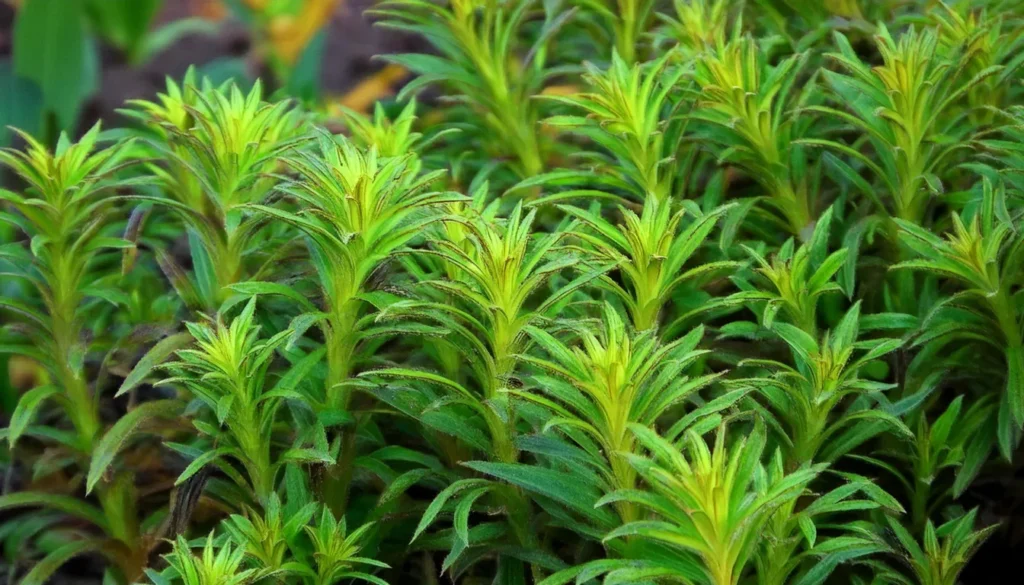
Key Takeaway
- Limnophila Aromatica is a popular aromatic herb with vibrant foliage that has attracted many freshwater aquarium hobbyists.
- It is known for its aromatic properties, fast growth rate, and adaptability, making it suitable for novice and experienced aquarists.
- In addition to its aesthetic appeal in aquascaping, Limnophila Aromatica has potential therapeutic benefits and culinary uses.
- Propagation techniques for Limnophila Aromatica include stem cuttings, side shoots, and seed propagation.
- By understanding the characteristics, propagation methods, and various applications of Limnophila Aromatica, we can appreciate its modern appeal and utilize it effectively.
Quick Stats
| Attribute | Details |
| Family Name | Plantaginaceae |
| Origin | Southeast Asia |
| Height | 20-40 cm (8-16 inches) |
| pH Range | 5.0 – 7.0 |
| CO2 Requirement | Moderate to High |
| Growth Rate | Fast |
| Care Level | Moderate |
| Color Form | Green leaves with purple to red undersides |
| Water Conditions | 22-28°C (72-82°F), soft to moderately hard water |
| Max Size | Can grow taller than 40 cm (16 inches) in optimal conditions |
| Lighting | Moderate to High |
| Supplements | Benefits from CO2 supplementation, iron, and comprehensive liquid fertilizers |
| Placement | Mid-ground to Background |
| Propagation | Stem cuttings |
What Is Limnophila Aromatica?
Limnophila Aromatica, or Rice Paddy Herb or Vietnamese Mint, is a perennial herb native to Southeast Asia.
It belongs to Plantaginaceae and is commonly found in wetlands, rice fields, and freshwater aquatic environments.
The plant features thin, elongated leaves and produces small purple flowers. Its unique aroma and vibrant color make it popular for aquascaping and culinary purposes.
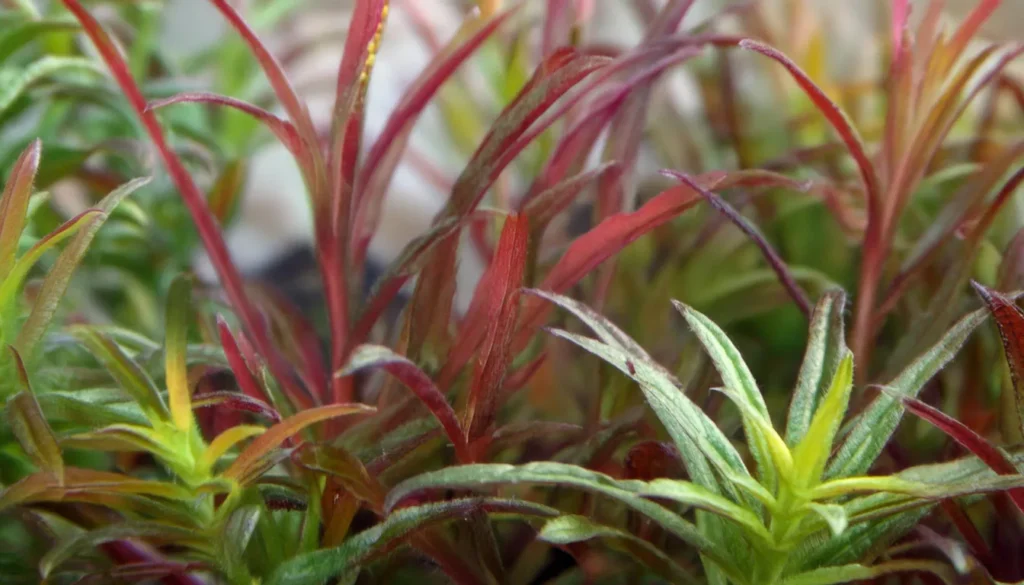
| Common Names | Scientific Name | Family | Native To |
| Rice Paddy Herb, Vietnamese Mint | Limnophila Aromatica | Plantaginaceae | Southeast Asia |
Natural Habitat And Origin
Limnophila aromatica, commonly known as Rice Paddy Herb or Vietnamese Mint, is native to Southeast Asia, including countries like India, Sri Lanka, Thailand, and Malaysia.
It typically grows in marshy or boggy areas, along the edges of rivers, streams, and rice paddies.
Limnophila aromatica thrives in tropical climates with warm temperatures and high humidity, making it well-adapted to its natural habitat in the region.
Characteristics Of Limnophila Aromatica
- Limnophila Aromatica possesses several distinctive characteristics that make it a desirable choice for aquarium and herb enthusiasts. The plant typically grows to a height of 10-30 inches and develops long, slender leaves that vary in color from green to reddish-brown, depending on the lighting conditions and nutrient availability.
- These unique characteristics contribute to the visual appeal of Limnophila Aromatica in both freshwater aquariums and herb gardens. Its towering presence adds vertical interest, while the varying leaf colors create a dynamic and vibrant display. Whether submerged in water or grown in soil, the plant exhibits its exceptional charm, making it a captivating addition to any setting.
Lighting Needs Of The Plant
- Limnophila aromatica generally prefers moderate to high lighting conditions to thrive in aquariums. Providing adequate lighting is crucial for promoting healthy growth and maintaining the plant’s vibrant coloration.
- Full-spectrum LED lights or fluorescent bulbs with a color temperature ranging from 5000K to 7000K are suitable for this plant species. Additionally, ensure consistent lighting duration of around 8 to 10 hours per day to simulate natural daylight cycles and support photosynthesis.
- Adjust lighting intensity and duration based on the specific needs of your aquarium setup and the growth rate of Limnophila aromatica. Regularly monitor plant health and adjust lighting as needed to prevent issues such as algae overgrowth or insufficient plant growth.
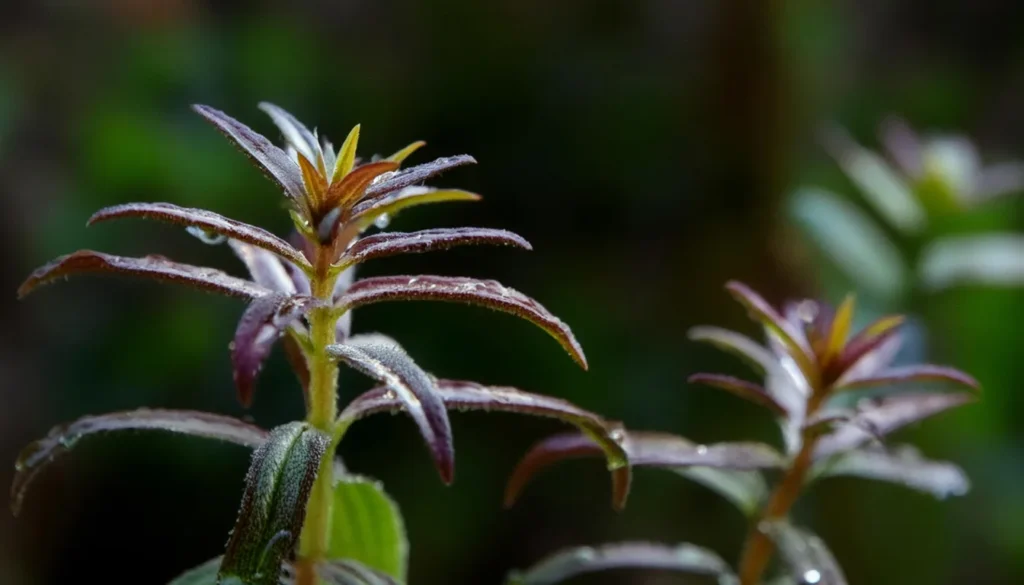
Temperature Needs For Robust Growth
Limnophila aromatica thrives in tropical temperatures typical of its natural habitat. To achieve robust growth in an aquarium setting, maintain water temperatures between 22°C to 28°C (72°F to 82°F).
These temperatures mimic the warm and humid conditions found in Southeast Asia, where the plant is native.
Consistently providing temperatures within this range helps promote healthy growth, encourages vibrant coloration, and supports overall plant vitality.
Use a reliable aquarium thermometer to monitor water temperature and ensure it remains within the optimal range for Limnophila aromatica.
Optimal Water Condition
- pH: Maintain a slightly acidic to neutral pH level in the range of 6.5 to 7.5. This pH range is suitable for nutrient uptake and ensures the overall health of the plant.
- Hardness: Limnophila aromatica can tolerate a wide range of water hardness levels, but it generally prefers soft to moderately hard water. Aim for a general hardness (GH) of 4 to 8 degrees and a carbonate hardness (KH) of 3 to 6 degrees.
- Temperature: Keep water temperatures between 22°C to 28°C (72°F to 82°F) to promote optimal growth. Consistent temperatures within this range mimic the warm, tropical conditions of the plant’s natural habitat.
- Nutrient Levels: Provide ample nutrients for healthy growth. Limnophila aromatica benefits from a nutrient-rich environment, so ensure the presence of essential macronutrients (nitrogen, phosphorus, potassium) and micronutrients (iron, magnesium, etc.). Regularly dose liquid fertilizers or root tabs to supplement nutrients as needed.
Substrate Requirement
- Nutrient-Rich Substrate: Choose a substrate that is rich in nutrients to support the growth of Limnophila aromatica. Nutrient-rich substrates often contain a blend of minerals, organic matter, and beneficial bacteria that promote plant growth. Look for substrates specifically designed for planted aquariums or ones labeled as nutrient-rich.
- Fine Gravel or Sand: Limnophila aromatica can be planted directly into fine gravel or sand substrates. These substrates allow for easy root penetration and provide stability for the plant’s delicate stems. Ensure that the substrate is free of sharp edges to prevent damage to the plant’s roots.
- Depth: Provide a substrate depth of at least 2 to 3 inches (5 to 7.5 centimeters) to allow ample room for root development and anchoring. A deeper substrate layer also provides stability for the plant and helps maintain water quality by trapping debris.
- Supplemental Nutrients: While a nutrient-rich substrate can provide some of the essential nutrients for plant growth, supplementing with root tabs or substrate fertilizers may be beneficial, especially in low-nutrient aquarium setups. Insert root tabs into the substrate around the base of Limnophila aromatica to provide a steady supply of nutrients directly to the roots.
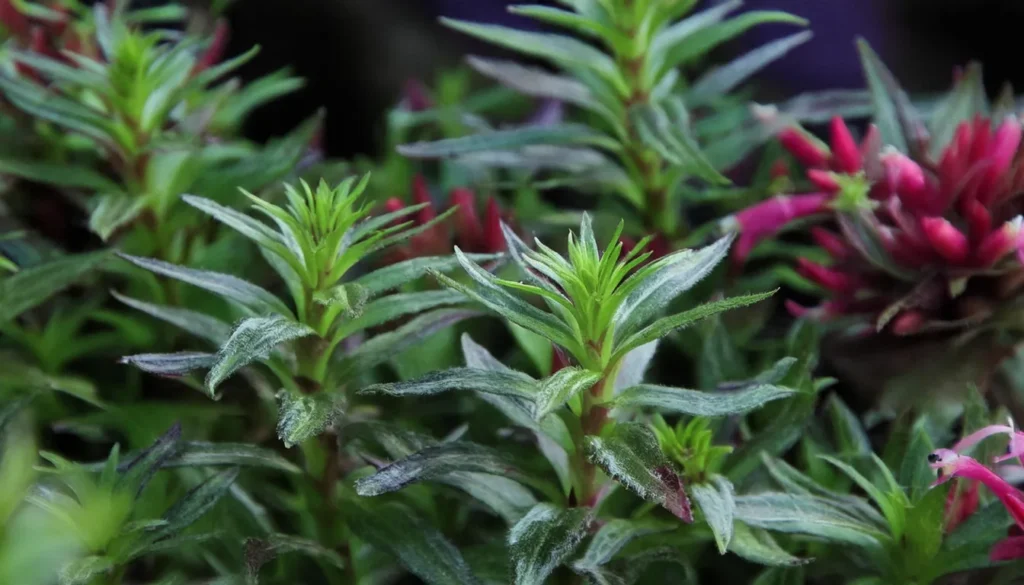
Placement Options
- Background: Limnophila aromatica can be placed in the background of the aquarium to create a lush green backdrop. Plant taller stems towards the rear of the tank to provide height and visual interest. This placement option helps fill in empty spaces and adds depth to the aquascape.
- Midground: Depending on the tank size, you can use Limnophila aromatica as a midground plant in smaller aquariums. Plant it in groups or clusters along the middle section of the tank to create a transition between the foreground and background plants. This placement adds texture and dimension to the aquascape.
- Borders: Use Limnophila aromatica to create borders along the sides or back of the aquarium. Plant it along the edges of the tank to define the space and frame the aquascape. This placement option adds structure and visual appeal to the overall layout.
- Group Planting: Plant Limnophila aromatica in groups or clusters to create focal points within the aquarium. Arrange the stems closely together to form dense, bushy patches of greenery. This placement option emphasizes the plant’s vibrant coloration and lush foliage.
Recommended Tank Size
- For smaller aquariums (under 20 gallons), Limnophila aromatica can still be incorporated, but it’s essential to consider its vigorous growth habit. Regular trimming and maintenance will be necessary to prevent overcrowding and maintain a balanced aquascape.
- In medium-sized tanks (20 to 50 gallons), Limnophila aromatica can be utilized effectively as a background or midground plant, providing height and lush greenery to the aquascape. Proper placement and spacing will ensure optimal growth and visual appeal.
- Larger tanks (over 50 gallons) offer more flexibility in incorporating Limnophila aromatica, allowing for extensive planting arrangements and creative aquascaping options. This size of the tank provides ample space for the plant to grow tall and bushy, creating a stunning backdrop or focal point in the aquarium.
RELATED: Cultivating Hemianthus Micranthemoides (Pearl Weed) For A Versatile Aquatic Oasis
Suitable Tank Mates
- Community Fish: Peaceful community fish species like tetras, rasboras, danios, guppies, and mollies can coexist harmoniously with Limnophila aromatica. These fish are generally compatible with the plant’s growth habits and won’t disturb its delicate stems.
- Bottom Dwellers: Bottom-dwelling fish such as Corydoras catfish and Otocinclus catfish can complement Limnophila aromatica by foraging around the substrate and keeping it clean. These fish species are peaceful and won’t damage the plant or uproot it.
- Shrimp: Dwarf shrimp species like Cherry shrimp and Amano shrimp make excellent tank mates for Limnophila aromatica. They help with algae control and add activity to the lower levels of the aquarium without posing a threat to the plant.
- Snails: Certain snail species, such as Nerite snails and Malaysian Trumpet snails, can coexist with Limnophila aromatica and contribute to the aquarium’s ecosystem by consuming algae and detritus. However, be cautious with larger snails like Apple snails, as they may accidentally damage the plant.
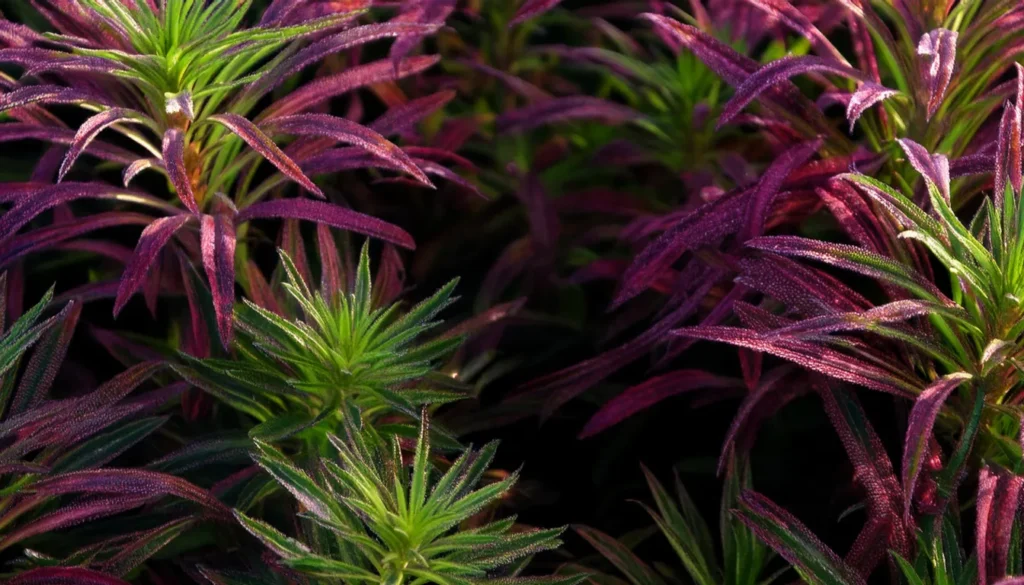
Plant Nutritional Needs
Limnophila aromatica requires essential nutrients to support its growth and development.
These include both macro and micronutrients, which are vital for various physiological processes such as photosynthesis, cell structure, and enzymatic reactions.
Here’s an overview of the plant’s nutritional needs:
Macronutrients
- Nitrogen (N): Nitrogen is crucial for the synthesis of chlorophyll, proteins, and nucleic acids. It promotes vigorous growth and lush foliage in Limnophila aromatica. Nitrogen deficiency can lead to stunted growth and yellowing of leaves.
- Phosphorus (P): Phosphorus is involved in energy transfer and cell division processes. It plays a key role in root development and overall plant health. Phosphorus deficiency may manifest as slow growth and dark green leaves with purplish undersides.
- Potassium (K): Potassium regulates water uptake, enzyme activation, and osmotic balance in plants. It enhances disease resistance and improves overall plant vigor. Potassium deficiency can result in weakened stems and poor nutrient uptake.
Micronutrients
- Iron (Fe): Iron is essential for chlorophyll synthesis and photosynthesis. It contributes to the plant’s green coloration and overall health. Iron deficiency can lead to chlorosis (yellowing of leaves) and poor growth.
- Magnesium (Mg): Magnesium is a component of chlorophyll and is involved in photosynthesis. It helps activate enzymes and plays a role in carbohydrate metabolism. Magnesium deficiency can cause interveinal chlorosis and leaf curling.
- Calcium (Ca) and Sulfur (S): Calcium and sulfur are essential for cell wall structure and integrity. They contribute to overall plant structure and function.
- Trace Elements: Other micronutrients such as manganese (Mn), zinc (Zn), copper (Cu), boron (B), and molybdenum (Mo) are required in smaller quantities but are equally important for plant growth and development.
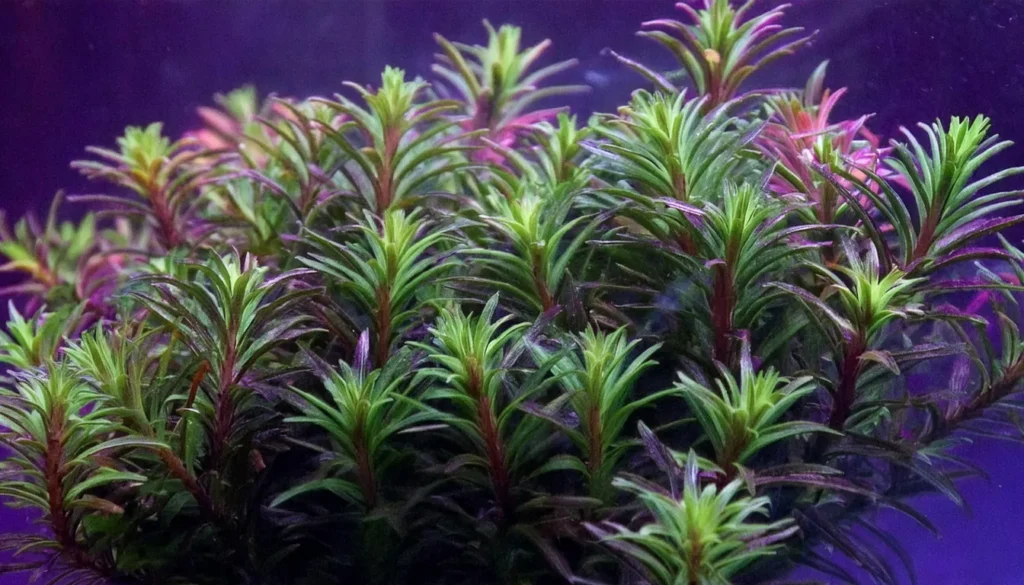
Cultivation Tips
- Nutrient Availability: Ensure ample nutrient availability for healthy growth. Use a comprehensive aquarium fertilizer regimen that includes both macro and micronutrients. Liquid fertilizers, root tabs, and nutrient-rich substrates can help meet the plant’s nutritional needs.
- CO2 Supplementation: Consider supplementing carbon dioxide (CO2) if possible. CO2 injection enhances growth and promotes vibrant coloration in Limnophila aromatica. However, it can still grow well in tanks without CO2 supplementation, albeit at a slower rate.
- Pruning and Maintenance: Regularly trim and prune the stems to encourage bushy growth and prevent overcrowding. Remove any dead or decaying plant material to maintain water quality and prevent nutrient imbalances.
- Propagation: Limnophila aromatica can be easily propagated by stem cuttings. Simply trim healthy stems and replant them in the substrate. Ensure that each cutting has several nodes to promote root development.
- Water Flow: Provide moderate water flow to ensure nutrient distribution and prevent debris buildup on the plant’s foliage. However, avoid excessive water flow, which may uproot or damage the delicate stems.
RELATED: Eleocharis Pusilla Guide For Proper Care, Tips & Growth
Limnophila Aromatica Propagation Techniques
- Stem Cuttings: Stem cuttings are the most commonly used and effective method for propagating Limnophila Aromatica. To do this, you must select a healthy stem from the parent plant and carefully cut it, ensuring each cutting is about 3-4 inches long. Once you have your cuttings, replant them in a suitable growing medium, such as nutrient-rich soil or a specialized aquatic substrate. Make sure to bury the cuttings at least an inch deep to promote root growth.
- Side Shoots: Limnophila Aromatica produces side shoots, also known as runners, which can be detached from the main plant and used for propagation. To propagate using side shoots, carefully separate them from the parent plant and plant them in their own growing medium. Ensure that each side shoot has roots attached to increase the chances of successful establishment.
- Seed Propagation: While less common, you can also propagate Limnophila Aromatica from seeds. Collect mature seeds from the plant and sow them in a suitable substrate. Keep the soil moist until the seeds germinate and establish themselves as seedlings. Seed propagation can be a slower process than other techniques, but watching your plants grow from the beginning can be rewarding.

Benefits Of Planting Limnophila Aromatica
- Aesthetic Appeal: Limnophila aromatica features vibrant green to reddish-purple foliage, adding visual interest and color contrast to your aquascape. Its bushy growth habit and fine-textured leaves create a lush and attractive backdrop in the aquarium.
- Natural Filtration: Like other aquatic plants, Limnophila aromatica helps improve water quality by absorbing nutrients such as nitrates and phosphates. This natural filtration process helps reduce algae growth and maintain a healthy aquatic ecosystem.
- Oxygenation: Through photosynthesis, Limnophila aromatica releases oxygen into the water, contributing to oxygenation and creating a healthier environment for fish and other aquatic inhabitants.
- Habitat Enhancement: The dense foliage of Limnophila aromatica provides shelter and hiding places for fish fry, shrimp, and other small aquatic organisms. It mimics the natural habitat of many freshwater species, reducing stress and promoting natural behaviors.
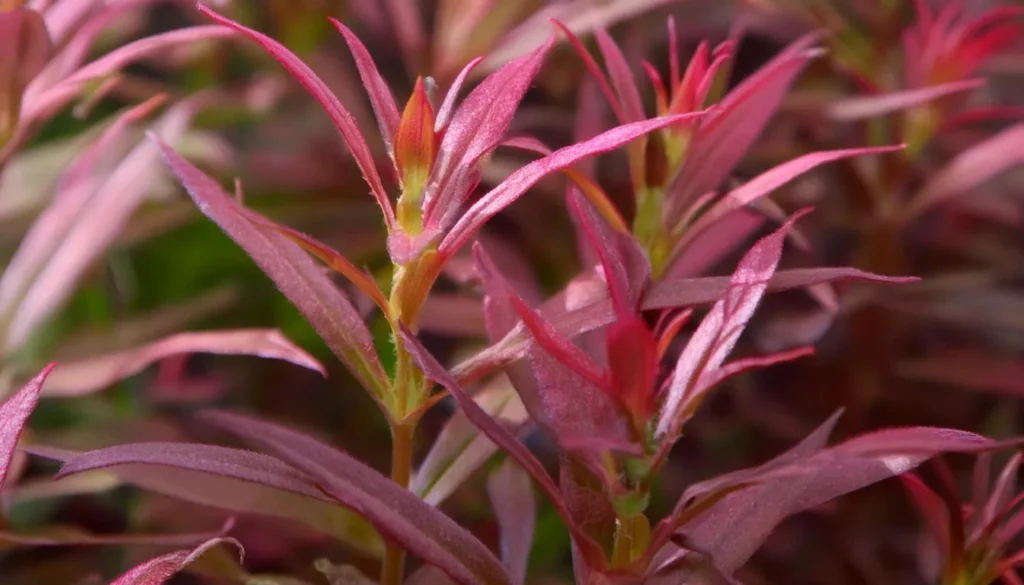
Conclusion
Limnophila Aromatica is truly a remarkable herb with a multitude of benefits and uses.
Whether you’re an aquarium enthusiast, a food lover, or someone seeking natural remedies, this versatile plant has something to offer.
By exploring its characteristics, propagation techniques, culinary uses, therapeutic potentials, and environmental significance, we can fully appreciate its modern appeal.
As we have discovered, Limnophila Aromatica adds a touch of elegance to freshwater aquariums, creating visually stunning aquatic landscapes.
Its unique aroma and vibrant color make it a favorite among aquascapers, who appreciate its ability to transform their underwater worlds.
Beyond its aesthetic value, Limnophila Aromatica also possesses potential therapeutic properties. Rich in antioxidants and believed to have anti-inflammatory effects, this herb could support overall health and well-being.
However, further research is needed to validate its traditional uses and medicinal benefits.
Additionally, Limnophila Aromatica finds its place in the culinary world, infusing dishes with refreshing mint-like flavors and aromas.
From salads and soups to stir-fries and marinades, incorporating this herb into various recipes can elevate our culinary creations’ taste and sensory experience.
Lastly, let us not forget Limnophila Aromatica’s environmental significance.
By serving as a natural filter and improving water quality, this plant contributes to the sustainability of freshwater ecosystems.
Responsible sourcing and cultivation practices will ensure its long-term viability and ecological balance.
Frequently Asked Questions
What Are The Therapeutic Potentials Of Limnophila Aromatica?
This plant has antioxidant properties and is believed to have anti-inflammatory and analgesic effects.
It has been used in traditional medicine to alleviate pain, reduce inflammation, and treat various conditions.
How Can Limnophila Aromatica Be Used In Culinary Applications?
This plant can be used in various recipes, such as salads, soups, stir-fries, curries, and marinades.
It adds a refreshing, mint-like scent and slightly spicy taste to dishes.
What Role Does Limnophila Aromatica Play In Environmental Sustainability?
Limnophila Aromatica helps improve water quality in freshwater ecosystems by absorbing excess nutrients and reducing the risk of algal blooms.
It also acts as a natural filter in freshwater aquariums.
What Are The Health Benefits Of The Pigments In Limnophila Aromatica?
This plant contains pigments such as anthocyanins, carotenoids, and chlorophyll, which have antioxidant and anti-inflammatory properties and may promote overall health.
How Can Conservation And Sustainability Be Practiced With Limnophila Aromatica?
It is important to source Limnophila Aromatica responsibly and avoid harvesting from wild populations. Sustainable cultivation techniques and proper waste management are also essential.
- Unveiling The Wonders Of Riccia Fluitans In Aquascapes - August 7, 2024
- Vallisneria Gigantea Var. Guide To Care And Cultivation At Home - July 31, 2024
- Vesicularia Dubyana Care & Growth Guide Tips For Beginner Gardeners - July 30, 2024
